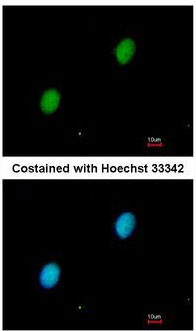HIF2A / EPAS1 Antibody
Rabbit Polyclonal Antibody
- SPECIFICATION
- CITATIONS
- PROTOCOLS
- BACKGROUND

Application
| WB, IHC-P, IF, ICC |
|---|---|
| Primary Accession | Q99814 |
| Reactivity | Human |
| Host | Rabbit |
| Clonality | Polyclonal |
| Calculated MW | 96kDa |
| Dilution | IF (1:100-1:200), IHC-P (10 µg/ml), WB (1:500-1:3000) |
| Gene ID | 2034 |
|---|---|
| Other Names | Endothelial PAS domain-containing protein 1, EPAS-1, Basic-helix-loop-helix-PAS protein MOP2, Class E basic helix-loop-helix protein 73, bHLHe73, HIF-1-alpha-like factor, HLF, Hypoxia-inducible factor 2-alpha, HIF-2-alpha, HIF2-alpha, Member of PAS protein 2, PAS domain-containing protein 2, EPAS1, BHLHE73, HIF2A, MOP2, PASD2 |
| Target/Specificity | Mouse (97%), Chicken (94%), Pig (99%), Rat (95%), Xenopus laevis (86%), Bovine (98%), Xenopus tropicalis (86%) |
| Reconstitution & Storage | Aliquot and store at -20°C. Minimize freezing and thawing. |
| Precautions | HIF2A / EPAS1 Antibody is for research use only and not for use in diagnostic or therapeutic procedures. |
| Name | EPAS1 |
|---|---|
| Synonyms | BHLHE73, HIF2A, MOP2, PASD2 |
| Function | Transcription factor involved in the induction of oxygen regulated genes. Heterodimerizes with ARNT; heterodimer binds to core DNA sequence 5'-TACGTG-3' within the hypoxia response element (HRE) of target gene promoters (By similarity). Regulates the vascular endothelial growth factor (VEGF) expression and seems to be implicated in the development of blood vessels and the tubular system of lung. May also play a role in the formation of the endothelium that gives rise to the blood brain barrier. Potent activator of the Tie-2 tyrosine kinase expression. Activation requires recruitment of transcriptional coactivators such as CREBBP and probably EP300. Interaction with redox regulatory protein APEX1 seems to activate CTAD (By similarity). |
| Cellular Location | Nucleus {ECO:0000250|UniProtKB:P97481, ECO:0000255|PROSITE-ProRule:PRU00981}. Nucleus speckle {ECO:0000250|UniProtKB:P97481}. Note=Colocalizes with HIF3A in the nucleus and speckles. {ECO:0000250|UniProtKB:P97481} |
| Tissue Location | Expressed in most tissues, with highest levels in placenta, lung and heart. Selectively expressed in endothelial cells |
| Volume | 50 µl |

Thousands of laboratories across the world have published research that depended on the performance of antibodies from Abcepta to advance their research. Check out links to articles that cite our products in major peer-reviewed journals, organized by research category.
info@abcepta.com, and receive a free "I Love Antibodies" mug.
Provided below are standard protocols that you may find useful for product applications.
Background
Transcription factor involved in the induction of oxygen regulated genes. Binds to core DNA sequence 5'-[AG]CGTG-3' within the hypoxia response element (HRE) of target gene promoters. Regulates the vascular endothelial growth factor (VEGF) expression and seems to be implicated in the development of blood vessels and the tubular system of lung. May also play a role in the formation of the endothelium that gives rise to the blood brain barrier. Potent activator of the Tie-2 tyrosine kinase expression. Activation seems to require recruitment of transcriptional coactivators such as CREBPB and probably EP300. Interaction with redox regulatory protein APEX seems to activate CTAD.
References
Tian H.,et al.Genes Dev. 11:72-82(1997).
Hogenesch J.B.,et al.J. Biol. Chem. 272:8581-8593(1997).
Ema M.,et al.EMBO J. 18:1905-1914(1999).
Furlow P.W.,et al.J. Biol. Chem. 284:9050-9058(2009).
Percy M.J.,et al.Blood 111:5400-5402(2008).
If you have used an Abcepta product and would like to share how it has performed, please click on the "Submit Review" button and provide the requested information. Our staff will examine and post your review and contact you if needed.
If you have any additional inquiries please email technical services at tech@abcepta.com.













 Foundational characteristics of cancer include proliferation, angiogenesis, migration, evasion of apoptosis, and cellular immortality. Find key markers for these cellular processes and antibodies to detect them.
Foundational characteristics of cancer include proliferation, angiogenesis, migration, evasion of apoptosis, and cellular immortality. Find key markers for these cellular processes and antibodies to detect them. The SUMOplot™ Analysis Program predicts and scores sumoylation sites in your protein. SUMOylation is a post-translational modification involved in various cellular processes, such as nuclear-cytosolic transport, transcriptional regulation, apoptosis, protein stability, response to stress, and progression through the cell cycle.
The SUMOplot™ Analysis Program predicts and scores sumoylation sites in your protein. SUMOylation is a post-translational modification involved in various cellular processes, such as nuclear-cytosolic transport, transcriptional regulation, apoptosis, protein stability, response to stress, and progression through the cell cycle. The Autophagy Receptor Motif Plotter predicts and scores autophagy receptor binding sites in your protein. Identifying proteins connected to this pathway is critical to understanding the role of autophagy in physiological as well as pathological processes such as development, differentiation, neurodegenerative diseases, stress, infection, and cancer.
The Autophagy Receptor Motif Plotter predicts and scores autophagy receptor binding sites in your protein. Identifying proteins connected to this pathway is critical to understanding the role of autophagy in physiological as well as pathological processes such as development, differentiation, neurodegenerative diseases, stress, infection, and cancer.


